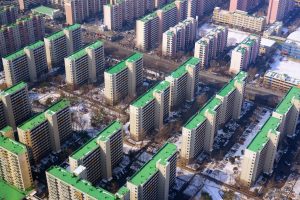Drive into any city in South Korea, and the most prominent feature from afar is their high-rise apartments. Of all the dwellings in the country – some 18 million – more than 60 percent are apartments. Add in smaller living complexes, and the share of multifamily homes rises to almost 80 percent. South Korea is the only OECD country where flats and apartments account for more than 70 percent of total housing stock.
But it wasn’t always like this. In 1975, apartments made up merely 1.9 percent of South Korean housing. By 2000, however, it had skyrocketed to 50 percent, followed by a steady soaring to the present day.
This heady spike corresponded to the life cycle of South Korean baby boomers. This generation, born between 1955 and 1974, numbers 17 million, or one third of South Korea’s entire population. As the impetus behind the country’s rapid industrialization and urbanization, they flocked to cities, expanded them, and erected new ones.
The appeal of apartments was great: proximity to public transportation and work, enhanced security against crimes, central heating against South Korea’s biting winter, shared amenities, and a sense of community. After they matured and married, their children needed easy access to quality education. And apartments were well-situated to land good schools and private education, the most important factor for South Koreans in choosing where to live.
But now the baby boomers are entering into a new phase: retirement. For the next 20 years, some 800,000 of them will retire each year. Their children are now adults, too, moving out and trying their luck alone. Now that the primary reasons – work and child-rearing – for living huddled with other households have disappeared, their apartments now feel cramped and the city air stuffy.
Living in solitary houses either in the suburb or the countryside topped baby boomers’ list of preferred housing options for their declining years. In fact, the Korea Research Institute for Human Settlements found that two-thirds of baby boomers currently living in cities wanted to relocate to the countryside. The volume of outmigration from urban to rural areas has already been increasing for the past few years, thanks to the baby boomers.
The momentum is building as their mass retirement is brewing. In the near future, they will profoundly change South Korea’s housing markets, and therefore, its landscape. More than 80 percent of them own real estate. The Korean Housing Association predicts a trend where they dispose of their pricey urban flats, move to the countryside, and live off the difference in sales. Indeed, there have been upticks in the monthly numbers of building permits for detached houses.
Accordingly, the construction industry is bracing. GS Engineering & Construction, for instance, launched a subsidiary called Xigeist, specializing in prefabricated timber houses. Unlike the conventional practice of building everything on-site, Xigeist’s modular units are pre-made in factories and stacked into a house. It’s the first time a South Korean conglomerate plunged into individual housing.
LG Electronics also chipped in. Using GS’s prefabrication techniques, LG created “smart cottages” equipped with its tailored home appliances for efficient climate control.
The industry expects the “prefab” market to turn into a multibillion-dollar business. In response, GS plans on building a larger factory, which, upon completion, will be able to pump out up to 1,500 modular houses every year.
While meeting the baby boomers’s fast-increasing demand for affordable houses outside of cities, the industry’s adaptation can also benefit the environment. Apartments are molded out of cement, a construction material that accounts for 8 percent of global carbon emissions. In addition, most apartment components can’t be recycled upon demolition, ending up as industrial waste. And their lengthy construction period engenders on-site pollution and noise.
Besides these environmental stumbling blocks, safety concerns are rife. Monitoring the quality and integrity of concrete structures is cumbersome and often overlooked. Hundreds of South Korean workers die a year from on-site accidents, too.
In contrast, a middling timber house stores 34 tons of carbon dioxide (CO2) in its structure, equivalent to what 45 automobiles guzzle up a year. Plus, its construction process releases four times less CO2 than its cement counterpart. Timber modules can also be transferred to different sites and expanded on, rather than razed and dumped in a landfill. If not, timber is always recyclable for other purposes.
This is important when construction-related sectors are responsible for almost 40 percent of global carbon emissions. Prefabricated modular construction meticulously tracks every component and process indoors to slash environmental footprint. Machines optimally handle materials and a minimum workforce engages in assembly. Less time is spent outdoors. According to Tuan Ngo at University of Melbourne, popularizing the prefab culture will help the building industry reach net zero emissions through low-carbon materials and better insulation.
Simultaneously, the baby boomers’ yearning for timber houses and the countryside can alleviate urban housing shortages for the young. The driving force behind exorbitant housing prices has been the enduring situation where baby boomers are staying put in their apartments while young people keep streaming into cities for jobs. The boomers’ exodus is the fastest way to boost urban housing supply and tamp down prices.
South Korea’s topography today traces the baby boomers’ life trajectory. Once the country’s workhorse, they are now trekking back to soil. Once again, they are leaving an indelible footprint in South Korea’s scenery.

































